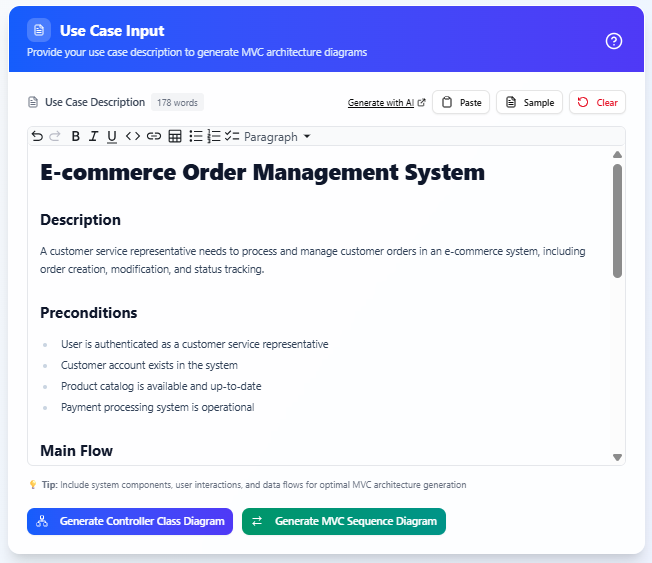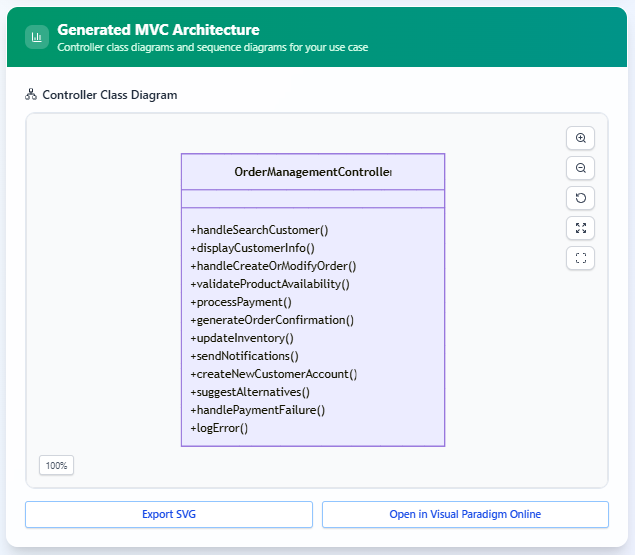A Comprehensive Guide to Using the MVC System Architecture Generator
This tutorial provides a step-by-step guide to using the MVC System Architecture Generator, a powerful tool designed to transform a use case description into a UML controller class diagram and an MVC sequence diagram. By leveraging AI, this tool bridges the gap between high-level requirements and implementation-level design, enabling developers to create precise, actionable blueprints for system development. Follow the steps below to navigate the tool and generate detailed UML artifacts for your use case.
Step-by-Step Guide
Step 1: Access the MVC System Architecture Generator
- Navigate to Tools in the main menu.
- Select Apps from the dropdown.
- Choose MVC System Architecture Generator.
- Click Start Now to open the tool.
Step 2: Provide the Use Case Description
In the MVC System Architecture Generator interface, locate the large text area provided for inputting the use case description.
Enter a detailed use case description, including:
-
Preconditions: Conditions that must be true before the use case begins.
-
Main Flow: The primary sequence of steps for the use case.
-
Alternative Flows: Variations or alternative scenarios.
-
Postconditions: The state of the system after the use case completes.
You can provide the use case description in the following ways:
-
Direct Input: Type the description directly into the text area.
-
Paste Content: Copy and paste a pre-prepared use case description from another source.
-
Use Case Description Generator: Generate a high-quality use case description using the separate Use Case Description Generator app, then paste it into the text area for optimal results.
Review the description to ensure it captures all relevant details. A comprehensive description leads to more accurate UML outputs.

Step 3: Generate the Controller Class Diagram
-
Once satisfied with the use case description, click Generate Controller Class Diagram.
-
The tool processes the input and produces a UML class diagram featuring a single controller class. This class includes all operations required to handle the use case, derived from the main and alternative flows.
-
For example, for a “Place Order” use case in an E-commerce Order Management System, the generated controller class (e.g., PlaceOrderController) might include operations such as:
-
+handleSearchCustomer()
-
+displayCustomerInfo()
-
+handleCreateOrModifyOrder()
-
+validateProductAvailability()
-
+processPayment()
-
+generateOrderConfirmation()
-
-
Review the generated class diagram to ensure the operations align with the use case requirements. If needed, revisit the use case description and regenerate the diagram.

Step 4: Generate the MVC Sequence Diagram
-
Click Generate MVC Sequence Diagram to produce a UML sequence diagram based on the same use case description.
-
The generated diagram follows the Model-View-Controller (MVC) pattern and includes:
-
Actor: The user or external entity interacting with the system.
-
View Lifeline: Represents the user interface components.
-
Controller Lifeline: Represents the controller class generated in Step 3.
-
Model Lifeline: Represents the data or business logic components.
-
-
The sequence diagram visualizes the interactions for the main flow and alternative flows, such as:
-
Normal scenario (e.g., successful order placement).
-
Alternative scenarios (e.g., invalid payment, out of stock, invalid shipping address).
-
Exceptional scenarios (e.g., payment gateway error, order cancellation).
-
-
Review the sequence diagram to ensure it accurately represents all scenarios described in the use case. If adjustments are needed, refine the use case description and regenerate the diagram.

Step 5: Refine and Export Diagrams
-
Both the controller class diagram and the MVC sequence diagram can be exported for further use or discussion.
-
If refinements are needed, click the Refine Sequence Diagram button, you can refine the generated sequence diagram to enhance lifelines, messages, interactions, and other diagram elements.
-
Use the integrated UML editor (e.g., Visual Paradigm Online) to manually refine the diagrams by adjusting lifelines, messages, or interactions, adding or modifying operations in the controller class, or enhancing the diagrams with additional annotations or formatting.
-
Export the diagrams in standard formats (e.g., SVG) for inclusion in documentation or presentations.
Conclusion
The MVC System Architecture Generator empowers developers to efficiently transition from high-level use case descriptions to detailed UML controller class and MVC sequence diagrams. By following the steps outlined in this tutorial, you can generate accurate, actionable blueprints for system implementation. Whether you’re designing an ATM system, an online platform, or any other application, this tool streamlines the process, saving time and enhancing precision. For further refinements, leverage integrated UML editors to tailor the diagrams to your exact requirements.

